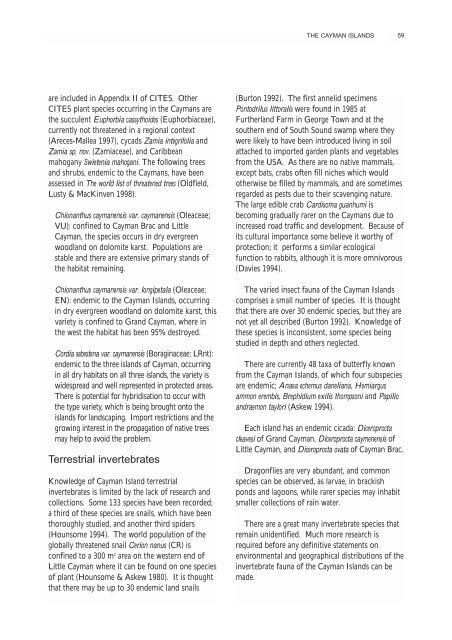Biodiversity: the UK Overseas Territories - WIDECAST
Biodiversity: the UK Overseas Territories - WIDECAST
Biodiversity: the UK Overseas Territories - WIDECAST
Create successful ePaper yourself
Turn your PDF publications into a flip-book with our unique Google optimized e-Paper software.
THE CAYMAN ISLANDS 59<br />
are included in Appendix II of CITES. O<strong>the</strong>r<br />
CITES plant species occurring in <strong>the</strong> Caymans are<br />
<strong>the</strong> succulent Euphorbia cassythoides (Euphorbiaceae),<br />
currently not threatened in a regional context<br />
(Areces-Mallea 1997), cycads Zamia integrifolia and<br />
Zamia sp. nov. (Zamiaceae), and Caribbean<br />
mahogany Swietenia mahogani. The following trees<br />
and shrubs, endemic to <strong>the</strong> Caymans, have been<br />
assessed in The world list of threatened trees (Oldfield,<br />
Lusty & MacKinven 1998).<br />
Chionanthus caymanensis var. caymanensis (Oleaceae;<br />
VU): confined to Cayman Brac and Little<br />
Cayman, <strong>the</strong> species occurs in dry evergreen<br />
woodland on dolomite karst. Populations are<br />
stable and <strong>the</strong>re are extensive primary stands of<br />
<strong>the</strong> habitat remaining.<br />
Chionanthus caymanensis var. longipetala (Oleaceae;<br />
EN): endemic to <strong>the</strong> Cayman Islands, occurring<br />
in dry evergreen woodland on dolomite karst, this<br />
variety is confined to Grand Cayman, where in<br />
<strong>the</strong> west <strong>the</strong> habitat has been 95% destroyed.<br />
Cordia sebestena var. caymanensis (Boraginaceae; LRnt):<br />
endemic to <strong>the</strong> three islands of Cayman, occurring<br />
in all dry habitats on all three islands, <strong>the</strong> variety is<br />
widespread and well represented in protected areas.<br />
There is potential for hybridisation to occur with<br />
<strong>the</strong> type variety, which is being brought onto <strong>the</strong><br />
islands for landscaping. Import restrictions and <strong>the</strong><br />
growing interest in <strong>the</strong> propagation of native trees<br />
may help to avoid <strong>the</strong> problem.<br />
Terrestrial invertebrates<br />
Knowledge of Cayman Island terrestrial<br />
invertebrates is limited by <strong>the</strong> lack of research and<br />
collections. Some 133 species have been recorded;<br />
a third of <strong>the</strong>se species are snails, which have been<br />
thoroughly studied, and ano<strong>the</strong>r third spiders<br />
(Hounsome 1994). The world population of <strong>the</strong><br />
globally threatened snail Cerion nanus (CR) is<br />
confined to a 300 m 2 area on <strong>the</strong> western end of<br />
Little Cayman where it can be found on one species<br />
of plant (Hounsome & Askew 1980). It is thought<br />
that <strong>the</strong>re may be up to 30 endemic land snails<br />
(Burton 1992). The first annelid specimens<br />
Pontodrilus littoralis were found in 1985 at<br />
Fur<strong>the</strong>rland Farm in George Town and at <strong>the</strong><br />
sou<strong>the</strong>rn end of South Sound swamp where <strong>the</strong>y<br />
were likely to have been introduced living in soil<br />
attached to imported garden plants and vegetables<br />
from <strong>the</strong> USA. As <strong>the</strong>re are no native mammals,<br />
except bats, crabs often fill niches which would<br />
o<strong>the</strong>rwise be filled by mammals, and are sometimes<br />
regarded as pests due to <strong>the</strong>ir scavenging nature.<br />
The large edible crab Cardisoma guanhumi is<br />
becoming gradually rarer on <strong>the</strong> Caymans due to<br />
increased road traffic and development. Because of<br />
its cultural importance some believe it worthy of<br />
protection; it performs a similar ecological<br />
function to rabbits, although it is more omnivorous<br />
(Davies 1994).<br />
The varied insect fauna of <strong>the</strong> Cayman Islands<br />
comprises a small number of species. It is thought<br />
that <strong>the</strong>re are over 30 endemic species, but <strong>the</strong>y are<br />
not yet all described (Burton 1992). Knowledge of<br />
<strong>the</strong>se species is inconsistent, some species being<br />
studied in depth and o<strong>the</strong>rs neglected.<br />
There are currently 48 taxa of butterfly known<br />
from <strong>the</strong> Cayman Islands, of which four subspecies<br />
are endemic; Anaea echemus daneliana, Hemiargus<br />
ammon erembis, Brephidium exilis thompsoni and Papilio<br />
andraemon taylori (Askew 1994).<br />
Each island has an endemic cicada: Diceroprocta<br />
cleavesi of Grand Cayman, Diceroprocta caymenensis of<br />
Little Cayman, and Diceroprocta ovata of Cayman Brac.<br />
Dragonflies are very abundant, and common<br />
species can be observed, as larvae, in brackish<br />
ponds and lagoons, while rarer species may inhabit<br />
smaller collections of rain water.<br />
There are a great many invertebrate species that<br />
remain unidentified. Much more research is<br />
required before any definitive statements on<br />
environmental and geographical distributions of <strong>the</strong><br />
invertebrate fauna of <strong>the</strong> Cayman Islands can be<br />
made.
















